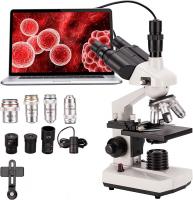What Can You See With A 1000x Microscope ?
With a 1000x microscope, you can see a wide range of microscopic details and structures. This level of magnification allows you to observe cells, bacteria, and other microorganisms in great detail. You can explore the intricate structures within cells, such as the nucleus, mitochondria, and other organelles. Additionally, you can examine the fine details of bacteria, including their shape, size, and any appendages they may have. This level of magnification also enables you to study microscopic particles, such as pollen grains, dust particles, or tiny crystals. Overall, a 1000x microscope provides a powerful tool for exploring the microscopic world and uncovering the hidden details of various specimens.
1、 Cellular structures and organelles in greater detail
With a 1000x microscope, you can observe cellular structures and organelles in greater detail. This level of magnification allows for a closer examination of the intricate components that make up a cell. By using a 1000x microscope, scientists and researchers can delve into the microscopic world and gain a deeper understanding of cellular biology.
At this magnification, you can observe the nucleus of a cell, which contains the genetic material and controls the cell's activities. The nucleolus, a substructure within the nucleus responsible for ribosome production, can also be seen more clearly. Additionally, the mitochondria, often referred to as the powerhouse of the cell, can be observed in greater detail. These organelles are responsible for generating energy for the cell.
Furthermore, a 1000x microscope allows for the observation of other organelles such as the endoplasmic reticulum, Golgi apparatus, and lysosomes. The endoplasmic reticulum is involved in protein synthesis and lipid metabolism, while the Golgi apparatus is responsible for modifying, sorting, and packaging proteins. Lysosomes, on the other hand, contain enzymes that break down waste materials within the cell.
It is important to note that the latest advancements in microscopy techniques, such as super-resolution microscopy, have pushed the boundaries of what can be observed at the cellular level. These techniques allow for even higher resolution and finer details to be captured. However, a 1000x microscope still provides a valuable tool for studying cellular structures and organelles, especially in educational settings and basic research.

2、 Bacteria and other microorganisms
With a 1000x microscope, you can observe a wide range of microscopic organisms, including bacteria and other microorganisms. Bacteria are single-celled organisms that are too small to be seen with the naked eye, but they become visible under a microscope. A 1000x magnification allows for a detailed examination of their structure, shape, and movement.
Bacteria are incredibly diverse and can be found in various environments, such as soil, water, and even within the human body. They play crucial roles in ecosystems, including nutrient cycling and decomposition. Some bacteria are beneficial, aiding in digestion and producing vitamins, while others can cause diseases.
In addition to bacteria, a 1000x microscope can reveal other microorganisms such as protozoa, fungi, and algae. Protozoa are single-celled eukaryotic organisms that can be found in water bodies and soil. They exhibit various shapes and sizes and are important components of aquatic ecosystems. Fungi, including molds and yeasts, can also be observed at this magnification. They are involved in decomposition and nutrient recycling processes.
Algae, which are photosynthetic organisms, can be seen with a 1000x microscope as well. They are found in aquatic environments and can range from single-celled to multicellular forms. Algae are important primary producers and play a vital role in the food chain.
It is worth noting that advancements in microscopy techniques and technology continue to enhance our understanding of microorganisms. New staining methods, fluorescent dyes, and digital imaging have allowed for more detailed observations and analysis of these microscopic organisms. Additionally, the use of electron microscopy provides even higher magnification and resolution, enabling scientists to study the ultrastructure of microorganisms at the nanoscale level.
In conclusion, a 1000x microscope allows for the observation of bacteria, protozoa, fungi, and algae. These microorganisms are essential components of ecosystems and have significant impacts on various aspects of life on Earth. Ongoing advancements in microscopy techniques will undoubtedly continue to expand our knowledge of these microscopic organisms and their intricate structures and functions.

3、 Blood cells and their morphology
With a 1000x microscope, one can observe and study various components of blood cells and their morphology in great detail. Blood is composed of different types of cells, including red blood cells (erythrocytes), white blood cells (leukocytes), and platelets (thrombocytes). Each of these cell types plays a crucial role in maintaining the body's overall health and functioning.
At a magnification of 1000x, red blood cells can be observed with remarkable clarity. These disc-shaped cells lack a nucleus and contain hemoglobin, a protein responsible for carrying oxygen throughout the body. By examining red blood cells under a microscope, one can assess their size, shape, and overall health. Any abnormalities, such as irregular shape or size, may indicate certain medical conditions like anemia or genetic disorders.
White blood cells, on the other hand, are crucial components of the immune system. They help defend the body against infections and foreign substances. With a 1000x microscope, the different types of white blood cells, such as neutrophils, lymphocytes, monocytes, eosinophils, and basophils, can be observed. This level of magnification allows for the examination of their structure, size, and any abnormalities that may indicate an immune response or underlying health issues.
Additionally, platelets, which are responsible for blood clotting, can be observed in detail with a 1000x microscope. These small, irregularly shaped cell fragments play a vital role in preventing excessive bleeding. By studying platelets under high magnification, their quantity, size, and functionality can be assessed, aiding in the diagnosis and monitoring of various bleeding disorders.
It is important to note that advancements in microscopy techniques and technologies continue to enhance our understanding of blood cells. For instance, newer techniques like fluorescence microscopy and confocal microscopy allow for the visualization of specific cellular components or molecular markers within blood cells. These advancements provide researchers with a more detailed and comprehensive view of blood cell morphology, enabling them to explore cellular interactions, identify abnormalities, and develop targeted treatments.
In conclusion, a 1000x microscope allows for the detailed examination of blood cells and their morphology. This level of magnification provides insights into the size, shape, and overall health of red blood cells, white blood cells, and platelets. Continued advancements in microscopy techniques further enhance our understanding of blood cell structure and function, leading to improved diagnostics and treatments in the field of hematology.

4、 Tissue samples and their cellular composition
With a 1000x microscope, one can observe tissue samples and their cellular composition in great detail. This level of magnification allows for the visualization of structures that are not visible to the naked eye, providing valuable insights into the intricate world of cells and tissues.
When examining tissue samples under a 1000x microscope, one can observe the various types of cells present within the tissue. Different cell types have distinct characteristics, such as size, shape, and arrangement, which can be identified and studied. For example, in a sample of lung tissue, one may observe the presence of epithelial cells lining the airways, as well as specialized cells like alveolar cells responsible for gas exchange.
Furthermore, a 1000x microscope enables the observation of cellular structures within the cells themselves. Organelles such as the nucleus, mitochondria, endoplasmic reticulum, and Golgi apparatus can be visualized, providing insights into the cellular processes occurring within the tissue. For instance, by examining a sample of muscle tissue, one can observe the arrangement of muscle fibers and the presence of specialized structures like myofibrils and sarcomeres.
It is important to note that the latest advancements in microscopy techniques, such as confocal microscopy and super-resolution microscopy, have further enhanced our ability to visualize cellular structures and processes. These techniques allow for even higher resolution and three-dimensional imaging, providing a more comprehensive understanding of tissue samples and their cellular composition.
In conclusion, a 1000x microscope allows for the detailed examination of tissue samples and their cellular composition. By observing the different cell types and their structures, researchers can gain valuable insights into the complex world of cells and tissues. The latest microscopy techniques continue to push the boundaries of what we can see, providing an ever-expanding understanding of the microscopic world.







































